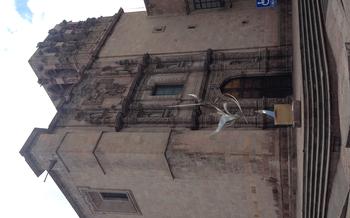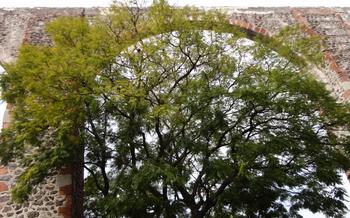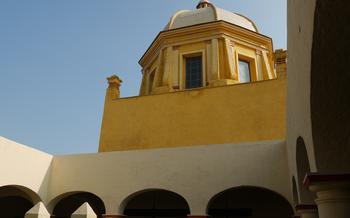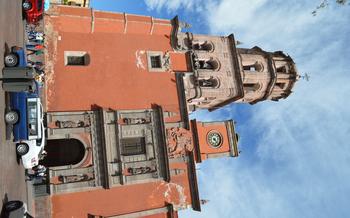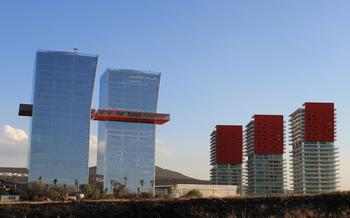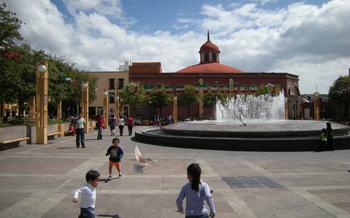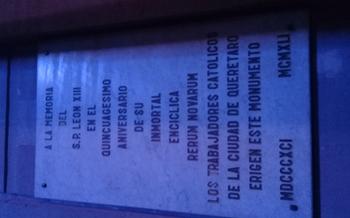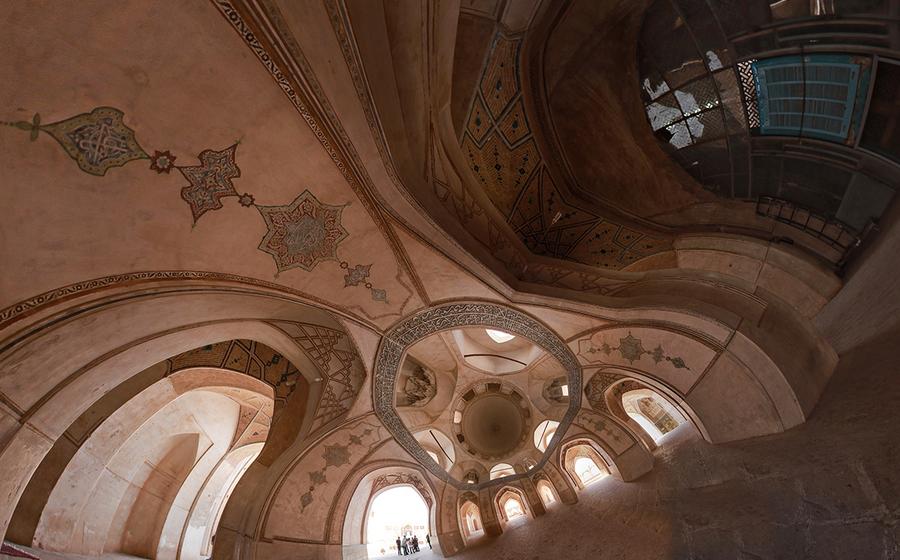
Museum of Sacred Art
- Location and Accessibility
- Curated Masterpieces
- Interactive Exhibits
- Cultural Significance
- Thematic Galleries
- Special Events
- Educational Programs
- Guided Tours
- Museum Shop
- Photography and Videography Policy
- Accessibility Features
- Visitor Tips
- Nearby Attractions
- Insider Tip: Unveiling the Secret Chamber
Location and Accessibility
The Museo de Arte Sacro de Querétaro is conveniently 14, a short stroll from the iconic Plaza de Armas. Its prime location makes it easily accessible on foot from various hotels, restaurants, and other attractions in the area.
Getting to the museum is a breeze, whether you choose to navigate the charming cobblestone streets on foot or utilize public transportation. The museum is well-connected by local buses, with several stops within walking distance. For those arriving by car, there are limited parking options available nearby.
Guided tours are offered in both Spanish and English, providing an enriching and informative experience for visitors of all linguistic backgrounds. These tours delve deeper into the museum's collection, offering insights into the history, significance, and techniques behind the sacred artworks.
Curated Masterpieces
The Museum of Sacred Art in Queretaro is home to an impressive collection of religious artwork from the 16th to the 19th centuries, showcasing the evolution of artistic styles and techniques during this period. Among the highlights of the collection are:
-
The Altarpiece of the Immaculate Conception (17th century): This stunning altarpiece is made of carved and gilded wood and features intricate depictions of the Virgin Mary, surrounded by angels and cherubs. It is a masterpiece of the Baroque style and is considered one of the most important works of art in the museum.
-
The Painting of the Last Supper (18th century): This large oil painting by an unknown artist depicts the Last Supper of Jesus with his disciples. It is a beautiful and moving work of art that captures the emotional intensity of this pivotal moment in Christian history.
-
The Sculpture of Saint Michael the Archangel (19th century): This wooden sculpture depicts Saint Michael the Archangel, the patron saint of Queretaro, standing triumphantly over a defeated demon. It is a powerful and evocative work of art that showcases the skill and artistry of the Mexican sculptor who created it.
These are just a few of the many masterpieces on display at the Museum of Sacred Art in Queretaro. The museum's collection is a testament to the rich artistic and cultural heritage of Mexico and is a must-see for anyone interested in religious art or Mexican history.
Interactive Exhibits
The Museum of Sacred Art in Queretaro enhances the visitor experience through interactive displays and workshops that bring the museum's collection to life. Visitors can engage with replicas of religious artifacts, allowing them to touch and examine intricate details up close. Hands-on activities like painting or sculpting workshops encourage visitors to express their own creativity, inspired by the artistic heritage of Mexico. These interactive exhibits not only educate but also foster a deeper appreciation for the craftsmanship and symbolism behind sacred art.
Cultural Significance
The Museum of Sacred Art plays a pivotal role in preserving and promoting the rich cultural heritage of Mexico. Its extensive collection of religious artifacts and artworks not only showcases the depth and diversity of Mexican artistry but also offers a glimpse into the country's complex religious history. Through its exhibitions and programs, the museum educates visitors about the profound influence of Catholicism on Mexican culture, highlighting how religious traditions have shaped the country's art, architecture, and social customs.
Moreover, the museum's collection serves as a testament to the enduring legacy of Mexican craftsmanship. The intricate carvings, exquisite paintings, and finely crafted textiles on display showcase the exceptional skills and artistry of Mexican artisans. By preserving and showcasing these masterpieces, the Museum of Sacred Art helps to promote and perpetuate the traditions of Mexican craftsmanship, ensuring their continued relevance and appreciation in contemporary society.
Furthermore, the museum actively engages with the local community through various educational programs and outreach initiatives. It offers workshops, lectures, and guided tours tailored to different age groups and interests, fostering a deeper understanding and appreciation of Mexican religious art and cultural heritage. By creating a space for dialogue and learning, the museum strengthens the bonds between the museum and the community, promoting a sense of cultural identity and pride.
Thematic Galleries
The Museum of Sacred Art in Queretaro is a treasure trove of artistic and cultural heritage, showcasing a diverse collection of religious artifacts, paintings, sculptures, and textiles. The museum is divided into several thematic galleries, each with a unique focus that immerses visitors in the rich history and traditions of Mexican religious art.
The Colonial Art Gallery takes you back in time to the early days of Spanish colonization, displaying exquisite pieces from the 16th to the 19th century. Admire intricate altarpieces, finely carved wooden sculptures, and paintings depicting biblical scenes and the lives of saints.
The Modern Art Gallery showcases a more contemporary perspective, featuring works by renowned Mexican artists who have reinterpreted religious themes through modern artistic styles. Bold colors, innovative techniques, and thought-provoking installations challenge traditional notions of sacred art.
The Textile Art Gallery is a celebration of the rich textile traditions of Mexico. Here, you'll find a vibrant display of intricately woven tapestries, embroidered garments, and ceremonial textiles that showcase the skill and artistry of indigenous artisans.
The Sculpture Gallery features an impressive collection of sculptures, both monumental and delicate, crafted from various materials such as wood, stone, and metal. From poignant representations of Christ to serene depictions of the Virgin Mary, these sculptures evoke a sense of awe and reverence.
Each gallery offers a distinct perspective on the diverse expressions of Mexican religious art, providing visitors with a deeper understanding of the country's rich cultural heritage.
Special Events
The Museum of Sacred Art in Queretaro is not just a repository of historical artifacts; it is also a vibrant cultural hub that hosts a variety of special events throughout the year. These events are designed to engage visitors of all ages and backgrounds, providing a deeper understanding of Mexican religious art and culture.
Workshops, concerts, and cultural events are regularly organized at the museum, offering visitors a chance to immerse themselves in the rich traditions of Mexico. During these events, participants can learn from renowned artists, musicians, and scholars, gaining insights into the creative process and the significance of religious art in Mexican society.
To ensure that everyone has the opportunity to participate, the museum often hosts these events free of charge or at a minimal cost. Visitors are encouraged to check the museum's website or social media pages for upcoming events and to register in advance to secure their spot.
Whether you are a devout Catholic, an art enthusiast, or simply someone with a curious mind, the special events at the Museum of Sacred Art offer a unique and enriching experience that will leave a lasting impression.
Educational Programs
The Museum of Sacred Art in Queretaro offers a variety of educational programs and workshops designed to engage visitors of all ages and interests. These programs aim to deepen the understanding and appreciation of Mexican religious art, history, and culture.
One of the most popular educational programs is the "Art History Workshop," which provides participants with an in-depth exploration of the museum's collection. Led by experienced art historians, the workshop delves into the techniques, styles, and symbolism of the artworks, offering participants a unique perspective on the development of Mexican religious art.
The museum also offers workshops on traditional Mexican crafts, such as pottery, weaving, and metalworking. These hands-on workshops allow visitors to learn about the rich artistic traditions of Mexico and create their own unique souvenirs.
For children and families, the museum offers a variety of interactive educational programs and activities. These programs include storytelling sessions, art classes, and scavenger hunts, designed to make learning about Mexican religious art fun and engaging for young visitors.
To participate in any of the educational programs or workshops, visitors can contact the museum's education department in advance to inquire about availability and registration procedures. These programs are an excellent way to enhance your visit to the Museum of Sacred Art and gain a deeper understanding of Mexican culture and heritage.
Guided Tours
For a more immersive and informative experience, consider booking a guided tour of the Museum of Sacred Art. Knowledgeable and passionate guides will lead you through the galleries, sharing insights into the history, significance, and symbolism of the artworks. Guided tours are available in Spanish and English and typically last for about an hour.
Cost and Duration
Guided tours typically cost around $5-$10 per person and last for approximately 60 minutes. It is advisable to book your tour in advance, especially during peak tourist season, to secure your spot and avoid any disappointment.
What to Expect
During your guided tour, you will gain a deeper understanding of the museum's collection and the significance of each artwork. Your guide will provide historical context, explain the techniques and styles used by the artists, and share fascinating stories and anecdotes related to the pieces. You will also have the opportunity to ask questions and engage in discussions with your guide.
Museum Shop
The Museum of Sacred Art's gift shop offers a unique selection of souvenirs and merchandise inspired by the museum's collection and Mexican religious art. From intricately designed rosaries and crucifixes to replicas of pre-Columbian sculptures, visitors can find a treasure trove of religious artifacts and mementos to take home. The shop also carries a range of books on Mexican art, history, and culture, providing visitors with an opportunity to deepen their understanding of the country's rich heritage.
Photography and Videography Policy
Photography and videography are generally allowed inside the Museum of Sacred Art, but there are certain guidelines that visitors must follow to ensure the preservation of the artworks and the tranquility of the environment. The use of flash photography is strictly prohibited, as it can damage the delicate paintings and sculptures. Visitors are also asked to refrain from taking photos or videos of other visitors without their consent.
Tripods and selfie sticks are not permitted inside the museum, as they can obstruct the flow of visitors and damage the exhibits. For those who wish to take professional photographs or videos for commercial purposes, prior permission must be obtained from the museum administration.
By adhering to these guidelines, visitors can help preserve the integrity of the museum's collection and ensure that everyone has a enjoyable and respectful experience.
Accessibility Features
The Museum of Sacred Art is committed to making its collection accessible to all visitors, regardless of their abilities. The museum offers a range of accessibility features to ensure that everyone can enjoy the museum's exhibits and programs.
The museum is fully wheelchair accessible, with ramps and elevators providing access to all levels of the building. There are also accessible restrooms and designated parking spaces for visitors with disabilities.
For visitors with visual impairments, the museum offers audio guides and tactile tours. The audio guides provide detailed descriptions of the artworks, while the tactile tours allow visitors to touch replicas of selected artworks.
For visitors with hearing impairments, the museum offers sign language interpreters for guided tours and programs. The museum also provides closed captioning for videos and films.
To request assistance or accommodations, visitors can contact the museum's accessibility coordinator in advance of their visit. The museum staff is happy to work with visitors to ensure that they have a positive and enjoyable experience.
Visitor Tips
To fully appreciate the treasures within, plan your visit during the museum's opening hours, which are typically from Tuesday to Sunday, excluding major holidays. To avoid crowds and ensure a serene experience, aim to arrive early in the morning or later in the afternoon.
Before embarking on your exploration, consider renting an audio guide or joining a guided tour to delve deeper into the stories behind the artworks. These guided tours are often led by knowledgeable docents who can provide insights and historical context, enhancing your understanding of the exhibits.
Dress modestly and respectfully, as the museum is a sacred space. Photography is generally permitted, but using a flash is prohibited to preserve the integrity of the artworks.
To make the most of your visit, take your time to admire each piece, allowing yourself to be captivated by their beauty and craftsmanship. Reflect on the cultural and historical significance of these artifacts, as they offer a glimpse into Mexico's rich religious heritage.
Nearby Attractions
The Museum of Sacred Art is nestled in the historic center of Queretaro, a UNESCO World Heritage Site. Take advantage of your visit to explore the city's other cultural gems, all within walking distance of the museum. Discover the grandeur of the 18th-century Templo de San Francisco, marvel at the baroque architecture of the Templo de Santa Rosa de Viterbo, or immerse yourself in the vibrant energy of the Plaza de Armas, the city's lively main square. For a taste of local history, visit the Museo Regional de Queretaro, housed in a former convent, or delve into the fascinating world of mummies at the Museo de las Momias. Queretaro is also renowned for its culinary delights; indulge in mouthwatering street food or savor the flavors of traditional Mexican cuisine at one of the many restaurants in the city center. Whether you're a history buff, an art enthusiast, or simply seeking a vibrant cultural experience, Queretaro offers a wealth of attractions to satisfy every traveler's curiosity.
Insider Tip: Unveiling the Secret Chamber
Beyond the main galleries, the Museum of Sacred Art holds a hidden gem—a secret chamber known only to a select few. This chamber houses a collection of rare and enigmatic artifacts, including ancient manuscripts, hidden relics, and forgotten treasures. To uncover this secret, visitors must seek out the museum's knowledgeable staff and inquire about the chamber. With a bit of luck and curiosity, they may be granted access to this hidden realm and discover the fascinating stories concealed within.

